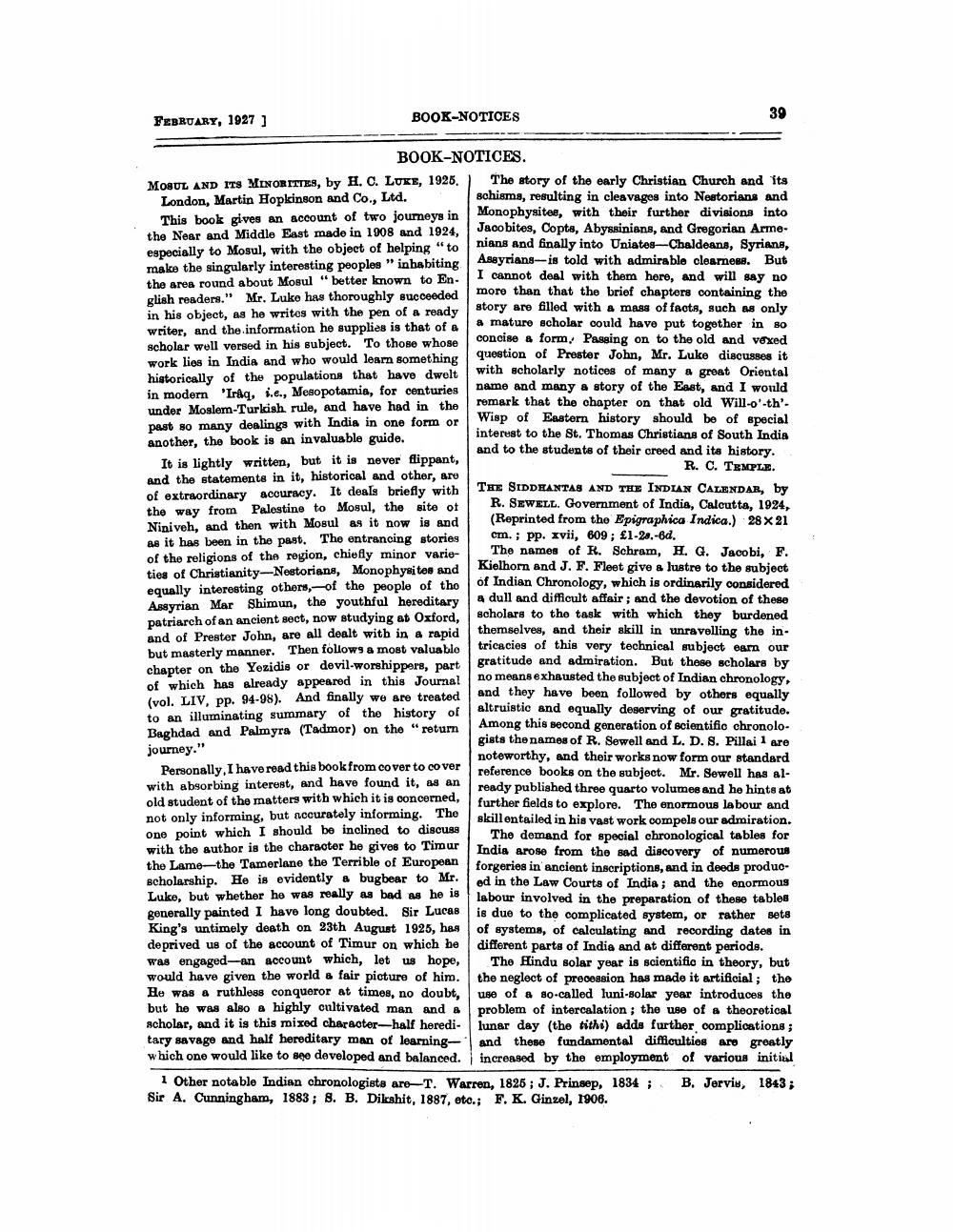________________
FEBRUARY, 1927]
BOOK-NOTICES
39
BOOK-NOTICES. MOAL AND ITS MINORITTES, by H. C. LUKE, 1928. The story of the early Christian Church and its London, Martin Hopkinson and Co., Ltd.
schisms, resulting in cleavages into Nestorians and This book gives an account of two journeys in Monophysitee, with their further divisions into the Near and Middle East made in 1908 and 1924, Jacobites, Copta, Abyssinians, and Gregorian Arme
nians and finally into Uniates-Chaldeana, Syriang, especially to Mosul, with the object of helping "to make the singularly interesting peoples "inhabiting
Assyrians--is told with admirable clearness. But
I cannot deal with them here, and will say no the area round about Mosul "better known to En. glish readers." Mr. Luke has thoroughly succeeded
more than that the brief chapters containing the in his object, as he writos with the pen of a ready
story are filled with a mass of facta, such as only writer, and the information he supplies is that of &
a mature scholar could have put together in so scholar well versed in his subject. To those whose
concise a form, Passing on to the old and vexed
question of Prester John, Mr. Luke discusses it work lies in India and who would learn something historically of the populations that have dwelt
with scholarly notices of many a great Oriental in modern 'Iraq, i.e., Mesopotamia, for centuries
name and many a story of the East, and I would under Moslern-Turkish rule, and have had in the remark that the chapter on that old Will-o'-th'past so many dealings with India in one form or
Wisp of Eastern history should be of special
interest to the St. Thomas Christians of South India another, the book is an invaluable guide.
and to the students of their creed and its history. It is lightly written, but it is never flippant,
R. C. TEMPLE. and the statements in it, historical and other, are of extraordinary accuracy.
THE SIDDHANTAS AND THE INDIAN CALENDAR, by
It deals briefly with the way from Palestine to Mosul, the site of
R. SEWELL. Government of India, Calcutta, 1924, Niniveh, and then with Mosul as it now is and (Reprinted from the Epigraphica Indica.) 28 x 21 as it has been in the past. The entrancing stories cm. ; pp. xvii, 609; £1-20.-Bd. of the religions of the region, chiefly minor varie- The names of R. Schram, H. G. Jacobi, F. ties of Christianity-Nestorians, Monophysites and Kielhorn and J. F. Fleet give a lustre to the subject equally interesting others, -of the people of the of Indian Chronology, which is ordinarily considered Assyrian Mar Shimun, the youthful hereditary
a dull and difficult affair; and the devotion of these patriarch of an ancient sect, now studying at Oxford, scholars to the task with which they burdened and of Prester John, are all dealt with in a rapid
themselves, and their skill in unravelling the in
tricacies of this very technical subject carn our but masterly manner. Then follows a most valuablo chapter on the Yezidis or devil-worshippers, part
gratitude and admiration. But these scholars by
no means exhausted the subject of Indian chronology of which has already appeared in this Journal
and they have been followed by others equally (vol. LIV, pp. 94-98). And finally we are treated
altruistic and equally deserving of our gratitude. to an illuminating summary of the history of Baghdad and Palmyra (Tadmor) on the return Among this second generation of scientifio chronolo
gists the names of R. Sewell and L. D. S. Pillai 1 are journey."
noteworthy, and their works now form our standard Personally, I have read this book from cover to cover
reference books on the subject. Mr. Sewell has alwith absorbing interest, and have found it, as an
ready published three quarto volumes and he hints at old student of the matters with which it is concerned,
further fields to explore. The enormous labour and not only informing, but accurately informing. The
skillentailed in his vast work compels our admiration. one point which I should be inclined to discuss
The demand for special chronological tables for with the author is the character he gives to Timur
India erose from the sad discovery of numerous the Lame-the Tamerlane the Terrible of European
forgeries in ancient inscriptions, and in deeds producscholarship. He is evidently & bugbear to Mr.
ed in the Law Courts of India, and the enormous Luke, but whether he was really as bad as he is
labour involved in the preparation of these tables generally painted I have long doubted. Sir Lucas
is due to the complicated system, or rather sets King's untimely death on 23th August 1925, hasof systems, of calculating and recording dates in deprived us of the account of Timur on which he different parts of India and at different periods. was engaged an account which, let us hope, The Hindu solar vear is scientific in theory. but would have given the world a fair picture of him. the neglect of precession has made it artificial; the He was a ruthless conqueror at times, no doubt, use of a so-called luni-solar year introduces the but he was also a highly cultivated man and a problem of intercalation; the use of a theoretical scholar, and it is this mixed character-half heredi- lunar day (the tithi) adds further complications ; tary savage and half hereditary man of learning--| and these fundamental difficulties are greatly which one would like to see developed and balanced. increased by the employment of various initial
1 Other notable Indian chronologists are-T. Warren, 1825; J. Prinsep, 1834 ; B. Jervis, 1843; Sir A. Cunningham, 1883; 8. B. Dikshit, 1887, sto.; F. K. Ginzel, 1906.




